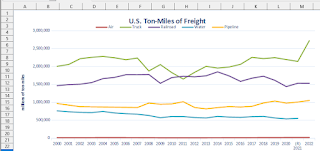At the risk of beating a dead horse, US Urban areas in 2024 are vulnerable to supply-chain disruptions.
If you were to ask a bubble-head who lived in the Bronx about supply-chains, she might dismiss it with a wave of her hands saying "I hardly buy anything. I won't be impacted."
Maybe. Maybe not.
Making numbers "real"
If you can believe government statistics, every man-woman-and-child in the US has the equivalent of their body-weight in freight shipped 650 miles EVERY DAY.
I am willing to bet that is much more than the bubble-head from the Bronx would estimate she based on the weight of the two cartons of Pork-fried-rice delivered by DoorDash from the other side of the block.
There is a huge amount of the supply chain or value-adding chain that is invisible to the end consumer.
That (Body-weight * 650 miles) does not include the 800 pounds of potable water that each person uses daily or the 2800 pounds of irrigation and industrial-processing water used every 24 hours.
"Oh, but I drink bottled water?" Bubble-head dismisses the idea that it would impact her. The classic reply is "What do you flush the toilet with?"
An idea that eludes most people is that a siege or blockade of NYC does not have to involve dropping the bridges leading to Manhattan (although it could). The economy of NYC could be tanked by dropping electrical power distribution equipment in Pennsylvania, bridges in Ohio and Virginia and gas-and-oil pipelines and fiber-optic trunks in North Carolina and West Virginia.
Attacking a remote choke-point only means that the shock-wave will be delayed days or perhaps a week as compared to dropping the Verrazano Narrows or RFK bridges.
California is even more vulnerable that NYC while Hawaii and Alaska are even more vulnerable than California.

Honestly Joe, given the % of Americans that take one or more (some far more) Medical Drugs (Insulin, heart meds BP meds, etc.) EVERYBODY has a long supply chain.
ReplyDeleteMost of THAT Chain goes to China as even the "American Made" drugs Pre-cursers are produced BY China. Sort of like the "Made in America" cars WITH Parts from Mexico.
Unless you're buying most of your food from local farmers (even yourself as my Feed Bills point out so hard) that % of food you ate today you didn't buy local came from far away.
Thus, my comment about pre-grid American population VS today.
A 90% reduction is highly likely even without a nuclear exchange if the grid fails for more than a few weeks. Water pumping is going to be a faster disaster than food.
I have a hand pump, spare parts and a second water pump because water is that important. Still A LOT of Work to pump water, haul water and give the livestock water.
Some of those chronic conditions are the result of "adjustments" to standards. A cholesterol level of 200 was considered "average" two decades ago and now anything over 200 is considered "high" and medical ethics require drug intervention. Blood Pressure thresholds for "High Blood Pressure" were lowered a few years ago.
DeletePop-quiz: What will the population of Saudi Arabia, which over-shot its human carrying capacity by a factor of 20, be when external supports are removed. If you guessed 5% of current, you would be wrong. It will be zero. 19 people will not give up their food so the one will survive. They all crash-and-burn.
You time horizons seem about right. Three days of delivery stoppage would wipe out groceries and restaurant inventory and then the Hunger Games begin.
In southern Michigan, it is very hard to get more than 30 miles from a significant urban area. Depending on how you measure (from fringe or from center) my patch of heaven is only 8-to-15 miles away from Lansing. At this stage of the game, I don't see any up-side to moving.
As others have discussed elsewhere, if society fails, it won't revert to the 1800's - it will go far further back except for those few who know how to live with what is then available.
DeleteIn the case of Saudi Arabia, I'd expect the population to go back to nomadic levels with a a few exceptions, such as modern weapons (minus anything requiring batteries).
Jonathan
Local is the only way you survive this crap. Local farms, local gardens including your own gardens. Local businesses, farmers markets, private beef producers. Local
ReplyDeleteAlso learning what and how to harvest natural growing foods that exist in your region would be valuable to stretch your resources. Food lines often have materials growing next to them who don't recognize it as food.
DeleteThink about the major roadways leading in and out nyc and the havoc than 100 lbs of roofing nails scattered judiciously would cause. No need to figure out power and fiber optic hubs, just a little scoop every hundred yards or so and… instant parking lot.
ReplyDeleteNYC exports sewage solids via rail lines to southern states for disposal. Stop the sewage from being processed and exported, watch the show.
ReplyDelete